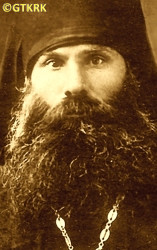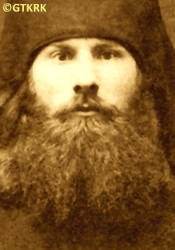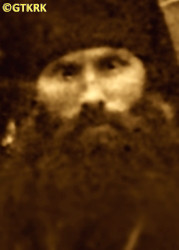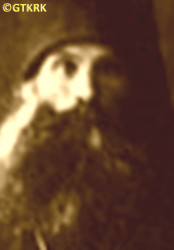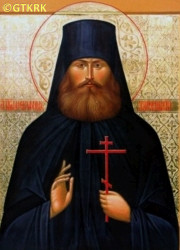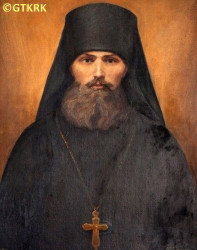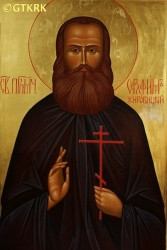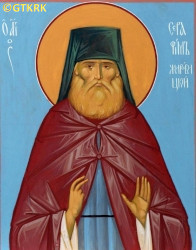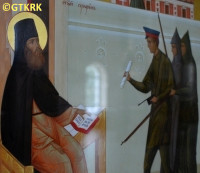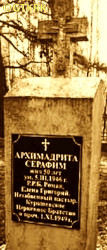Roman Catholic
St Sigismund parish
05-507 Słomczyn
85 Wiślana Str.
Konstancin deanery
Warsaw archdiocese, Poland
full list:
displayClick to display full list

searchClick to search full list by categories
wyświetlKliknij by wyświetlić pełną listę po polsku

szukajKliknij by przeszukać listę wg kategorii po polsku

Martyrology of the clergy — Poland
XX century (1914 – 1989)
personal data
religious status
saint
surname
SZACHMUĆ
forename(s)
Roman
religious forename(s)
Seraphim (pl. Serafin)
canonisation date
28.10.1999

Council of Bishops of the Belarus Orthodox Church
function
hieromonk
creed
Eastern Orthodox Church ORmore on
en.wikipedia.org
[access: 2014.09.21]
diocese / province
Grodno‐Novogrod OR eparchy (Polish Autocephalous Orthodox Church)more on
drevo-info.ru
[access: 2020.09.24]
date and place
of death
05.03.1946

ITL UnzhLagGuLAG slave labour camp network
today: Nizhny Novgorod oblast, Russia
more on
en.wikipedia.org
[access: 2022.01.09]
alt. dates and places
of death
1946
details of death
After German and Russian invasion of Poland in 09.1939 and start of the World War II, after German attack on 22.06.1941 of their erstwhile ally, Russians, and start of German occupation, went to eastern Belarus where on the territories liberated by Germans from Russian communists, for c. 20 years let without any pastoral care — visisted, among others, Kopyl, Slutsk, Uzda (1941), Minsk (1941‐1942), Vitebsk region (1942), Orsha, Bykhiv, Zhlobin, Mogilev, Ragachov, Bobruisk, Gomel (e.g. nearby Khonky village), Minsk again, where ministered in the Ortodox cathedral (1943‐1944).
Attempted to set up new parishes and monasteries.
Collected information about repressions against Orthodox church by the communists.
After German defeat in 1944 and start of another Russian occupation arrested by the genocidal Russian NKVD in Grodno on 06.09.1944.
After 5 days of interrogations moved to Minsk.
Accused of collaboration with German security forces Sicherheitsdienst SD.
In prison got a heart condition.
On 07.07.1945 sentenced to 5 years in Russian slave labour concentration camps Gulag.
Taken to Sukhobezvodnoye train station and from there to one of a few dozen camps in ITL UnzhLag concentration camp system.
There perished — prob. was tortured: locked in a solitary cell filled with water.
alt. details of death
According to some sources tied to two trucks and torn apart.
According to others perished in a prison of Russian genocidal NKVD organisation.
cause of death
extermination
perpetrators
Russians
sites and events
ITL UnzhLagClick to display the description, GulagClick to display the description, MinskClick to display the description, GrodnoClick to display the description, Ribbentrop‐MolotovClick to display the description
date and place
of birth
15.01.1901

Padlyesyetoday: Zherebkovichi ssov., Lyakhavichy dist., Brest reg., Belarus
more on
be.wikipedia.org
[access: 2022.08.05]
parents
SZACHMUĆ Roman
🞲 ?, ? — 🕆 ?, ?

Helen
🞲 ?, ? — 🕆 ?, ?
religious vows
01.04.1923 (permanent)
presbyter (holy orders)
ordination
1935

positions held
from 06.1944
priest — Grodnotoday: Grodno dist., Grodno reg., Belarus
more on
en.wikipedia.org
[access: 2023.01.18] ⋄ Intercession of the Blessed Virgin Mary OR cathedral church
c. 1943
priest — Minsktoday: Minsk city reg., Belarus
more on
en.wikipedia.org
[access: 2020.07.31] ⋄ St Mary Magdalene OR parish
11.1941 – 1942
priest — Minsktoday: Minsk city reg., Belarus
more on
en.wikipedia.org
[access: 2020.07.31] ⋄ OR church
c. 1939
Archimandrite, i.e. superior abbot — Polish Autocephalous Orthodox Church PACP — dignity conferment
1939 – 1941
hegumen–superior — Zhirovichitoday: Zhirovichi ssov., Slonim dist., Grodno reg., Belarus
more on
be.wikipedia.org
[access: 2022.11.09] ⋄ Polish Autocephalous Orthodox Church PACP ⋄ Assumption of the Blessed Virgin Mary OR monastery
from 30.01.1939
administrator — Melkanovichitoday: Kosteni ssov., Slonim dist., Grodno reg., Belarus
more on
be.wikipedia.org
[access: 2024.01.26] ⋄ Dormition of the Blessed Virgin Mary OR parish — acting („ad interim”)
from 10.12.1937
hieromonk — Zhirovichitoday: Zhirovichi ssov., Slonim dist., Grodno reg., Belarus
more on
be.wikipedia.org
[access: 2022.11.09] ⋄ Polish Autocephalous Orthodox Church PACP ⋄ Assumption of the Blessed Virgin Mary OR monastery
1935 – 1937
priest — Kuraszewotoday: Czyże gm., Hajnówka pov., Podlaskie voiv., Poland
more on
en.wikipedia.org
[access: 2022.05.02] ⋄ St Anthony of the Caves OR parish — acting („ad interim”)
1935
hieromonk — Zhirovichitoday: Zhirovichi ssov., Slonim dist., Grodno reg., Belarus
more on
be.wikipedia.org
[access: 2022.11.09] ⋄ Polish Autocephalous Orthodox Church PACP ⋄ Assumption of the Blessed Virgin Mary OR monastery — priesthood cheirotonia, i.e. ordination
1926 – 1935
hierodeacon — Zhirovichitoday: Zhirovichi ssov., Slonim dist., Grodno reg., Belarus
more on
be.wikipedia.org
[access: 2022.11.09] ⋄ Polish Autocephalous Orthodox Church PACP ⋄ Assumption of the Blessed Virgin Mary OR monastery — diaconate cheirotonia, i.e. ordination in 1926; also: head of the monastery choir, monastery treasurer
1923 – 1926
monk — Zhirovichitoday: Zhirovichi ssov., Slonim dist., Grodno reg., Belarus
more on
be.wikipedia.org
[access: 2022.11.09] ⋄ Polish Autocephalous Orthodox Church PACP ⋄ Assumption of the Blessed Virgin Mary OR monastery
06.1922 – 04.1923
novice — Zhirovichitoday: Zhirovichi ssov., Slonim dist., Grodno reg., Belarus
more on
be.wikipedia.org
[access: 2022.11.09] ⋄ Assumption of the Blessed Virgin Mary OR monastery
c. 1921 – c. 1922
psalmist — Vieliacičytoday: Pleshchitsy ssov., Pinsk dist., Brest reg., Belarus
more on
be.wikipedia.org
[access: 2023.04.10] ⋄ Nativity of the Blessed Virgin Mary OR church (fillial) — pslamist exams – 1921
1916 – 1917
novice — Minsktoday: Minsk city reg., Belarus
more on
en.wikipedia.org
[access: 2020.07.31] ⋄ Holy Spirit OR monastery (stavropegial) — novitiate interrupted due to the family and political situation
c. 1915
accession — Minsktoday: Minsk city reg., Belarus
more on
en.wikipedia.org
[access: 2020.07.31] ⋄ Holy Spirit OR monastery (stavropegial)
others related
in death
KULHAWIECClick to display biography Simeon, STEPANIUKClick to display biography George, HUTKOClick to display biography Basil (Bp Ambrose), NIKATOWClick to display biography Alex, OSTROUMOWClick to display biography Michael (Bp Seraphim), SAWICKIClick to display biography Yaroslav, SIENKIEWICZClick to display biography Alex, GAGALUKClick to display biography Anthony (Abp Onuphrius), STROCIUKClick to display biography Leontius, BLUMOWICZClick to display biography John, PANASIEWICZClick to display biography Emilian, MIEDWIEDIUKClick to display biography Vladimir, SMOLENIECClick to display biography Alexander (Abp Arsenius), MARCENKOClick to display biography Alexander (Abp Anthony), BORZAKOWSKIClick to display biography Alexander (Abp Agapit), DIERNOWClick to display biography Anatol (Abp Abramius)
sites and events
descriptions
ITL UnzhLag: Russian Rus. Исправи́тельно‐Трудово́й Ла́герь (Eng. Corrective Labor Camp) ITL Rus. Унженский (Eng. Unzhenskiy) — concentration and slave forced labor camp (within the Gulag complex) — headquartered in the village of Sukhobezvodnoye in the Nizhny Novgorod region (then Gorky), on the Unzha River. Founded on 05.02.1938. Prisoners slaved at the forest clearing, production and supply of firewood intended for Moscow, production of skis and ski semi‐finished products, railway sleepers, furniture, watch cases, as well as clothes, shoes, pottery, in the construction and maintenance of railway lines and roads, railway depots, in mechanical and repair workshops, etc. At its peak — till the death on 05.03.1953 of Russian socialist leader, Joseph Stalin — c. 30,000 prisoners were held there (in c. 30 sub‐camps): e.g. 19,986 (01.01.1940); 23,676 (01.01.1941); 27,278 (01.07.1941); 24,020 (01.04.1942); 23,904 (01.01.1943); 30,146 (01.01.1948); 30,210 (01.01.1950); 29,282 (01.01.1952); 29,551 (01.01.1953); 25,351 (01.01.1954); 23,124 (01.01.1955); 22,355 (01.01.1956). Among them, 30‐50% were considered „political”. 5‐20% were women. In 1949, half of the clergy imprisoned in Russia, 1,876 out of 3,523, were held captive there. Ceased to exist in 1960. (more on: old.memo.ruClick to attempt to display webpage
[access: 2024.04.08])
Gulag: The acronym Gulag comes from the Rus. Главное управление исправительно‐трудовых лагерей и колоний (Eng. Main Board of Correctional Labor Camps). The network of Russian concentration camps for slave labor was formally established by the decision of the highest Russian authorities on 27.06.1929. Control was taken over by the OGPU, the predecessor of the genocidal NKVD (from 1934) and the MGB (from 1946). Individual gulags (camps) were often established in remote, sparsely populated areas, where industrial or transport facilities important for the Russian state were built. They were modeled on the first „great construction of communism”, the White Sea‐Baltic Canal (1931‐1932), and Naftali Frenkel, of Jewish origin, is considered the creator of the system of using forced slave labor within the Gulag. He went down in history as the author of the principle „We have to squeeze everything out of the prisoner in the first three months — then nothing is there for us”. He was to be the creator, according to Alexander Solzhenitsyn, of the so‐called „Boiler system”, i.e. the dependence of food rations on working out a certain percentage of the norm. The term ZEK — prisoner — i.e. Rus. заключенный‐каналоармец (Eng. canal soldier) — was coined in the ITL BelBaltLag managed by him, and was adopted to mean a prisoner in Russian slave labor camps. Up to 12 mln prisoners were held in Gulag camps at one time, i.e. c. 5% of Russia's population. In his book „The Gulag Archipelago”, Solzhenitsyn estimated that c. 60 mln people were killed in the Gulag until 1956. Formally dissolved on 20.01.1960. (more on: en.wikipedia.orgClick to attempt to display webpage
[access: 2024.04.08])
Minsk: Russian prison. In 1937 site of mass murders perpetrated by the Russians during a „Great Purge”. After Russian invasion of Poland in 09.1939 and start of the World War II place of incarceration of many Poles, In 06.1941, under attack by Germans, Russians murdered there a group of Polish prisoner kept in Central and co‐called American prisons in Mińsk. The rest were driven towards Chervyen in a „death march” (10,000‐20,000 prisoners perished), into Russia. (more on: pl.wikipedia.orgClick to attempt to display webpage
[access: 2013.08.17])
Grodno: Prison used both by the Russians (in 1920, 1939‐1941 and from 1944) and the Germans (in 1941‐1944). Thousands of Poles were jailed there.
Ribbentrop‐Molotov: Genocidal Russian‐German alliance pact between Russian leader Joseph Stalin and German leader Adolf Hitler signed on 23.08.1939 in Moscow by respective foreign ministers, Mr. Vyacheslav Molotov for Russia and Joachim von Ribbentrop for Germany. The pact sanctioned and was the direct cause of joint Russian and German invasion of Poland and the outbreak of the World War II in 09.1939. In a political sense, the pact was an attempt to restore the status quo ante before 1914, with one exception, namely the „commercial” exchange of the so‐called „Kingdom of Poland”, which in 1914 was part of the Russian Empire, fore Eastern Galicia (today's western Ukraine), in 1914 belonging to the Austro‐Hungarian Empire. Galicia, including Lviv, was to be taken over by the Russians, the „Kingdom of Poland” — under the name of the General Governorate — Germany. The resultant „war was one of the greatest calamities and dramas of humanity in history, for two atheistic and anti‐Christian ideologies — national and international socialism — rejected God and His fifth Decalogue commandment: Thou shall not kill!” (Abp Stanislav Gądecki, 01.09.2019). The decisions taken — backed up by the betrayal of the formal allies of Poland, France and Germany, which on 12.09.1939, at a joint conference in Abbeville, decided not to provide aid to attacked Poland and not to take military action against Germany (a clear breach of treaty obligations with Poland) — were on 28.09.1939 slightly altered and made more precise when a treaty on „German‐Russian boundaries and friendship” was agreed by the same murderous signatories. One of its findings was establishment of spheres of influence in Central and Eastern Europe and in consequence IV partition of Poland. In one of its secret annexes agreed, that: „the Signatories will not tolerate on its respective territories any Polish propaganda that affects the territory of the other Side. On their respective territories they will suppress all such propaganda and inform each other of the measures taken to accomplish it”. The agreements resulted in a series of meeting between two genocidal organization representing both sides — German Gestapo and Russian NKVD when coordination of efforts to exterminate Polish intelligentsia and Polish leading classes (in Germany called «Intelligenzaktion», in Russia took the form of Katyń massacres) where discussed. Resulted in deaths of hundreds of thousands of Polish intelligentsia, including thousands of priests presented here, and tens of millions of ordinary people,. The results of this Russian‐German pact lasted till 1989 and are still in evidence even today. (more on: en.wikipedia.orgClick to attempt to display webpage
[access: 2015.09.30])
sources
personal:
pl.wikipedia.orgClick to attempt to display webpage
[access: 2020.09.24], zhirovichi-monastery.byClick to attempt to display webpage
[access: 2020.09.24], www.bu.kul.plClick to attempt to display webpage
[access: 2020.09.24], zapadrus.suClick to attempt to display webpage
[access: 2020.09.24], pravminsk.byClick to attempt to display webpage
[access: 2020.09.24]
bibliographical:
„Hierachy, clergy and employees of the Orthodox Church in the 19th‐21st centuries within the borders of the Second Polish Republic and post–war Poland”, Fr Gregory Sosna, M. Antonine Troc-Sosna, Warsaw–Bielsk Podlaski 2017
original images:
commons.wikimedia.orgClick to attempt to display webpage
[access: 2020.09.24], commons.wikimedia.orgClick to attempt to display webpage
[access: 2020.09.24], zhirovichi-monastery.byClick to attempt to display webpage
[access: 2020.09.24], zapadrus.suClick to attempt to display webpage
[access: 2020.09.24], polit.ruClick to attempt to display webpage
[access: 2020.09.24], monasterium.byClick to attempt to display webpage
[access: 2020.09.24], hramik.cerkov.ruClick to attempt to display webpage
[access: 2020.09.24], azbyka.ruClick to attempt to display webpage
[access: 2020.09.24], zhirovichi-monastery.byClick to attempt to display webpage
[access: 2020.09.24], zapadrus.suClick to attempt to display webpage
[access: 2020.09.24]
LETTER to CUSTODIAN/ADMINISTRATOR
If you have an Email client on your communicator/computer — such as Mozilla Thunderbird, Windows Mail or Microsoft Outlook, described at WikipediaPatrz:
en.wikipedia.org, among others — try the link below, please:
LETTER to CUSTODIAN/ADMINISTRATORClick and try to call your own Email client
If however you do not run such a client or the above link is not active please send an email to the Custodian/Administrator using your account — in your customary email/correspondence engine — at the following address:

giving the following as the subject:
MARTYROLOGY: SZACHMUĆ Roman
To return to the biography press below:
 Click to return to biography
Click to return to biography








